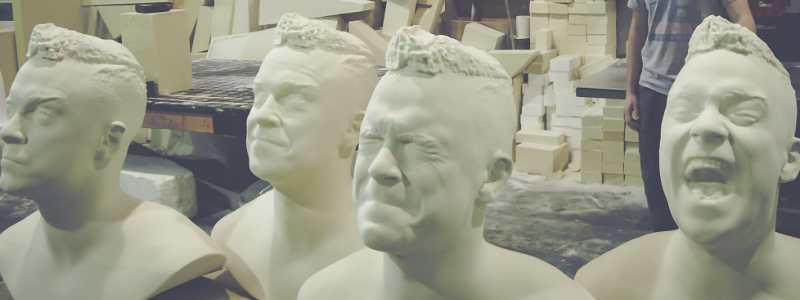How Foam Modelling Is Used in The Movie Industry
Bakers Patterns | 31st July 2020

Robbie Williams Polyurethane foam heads
Nowadays, a lot of what we see on movie screens is made on computers. It is no secret that CGI has taken over the movie industry, but there’s still something truly fascinating about seeing something physical on the screen; helping to bring worlds to life while making you feel almost a part of the movie.
So how do they do it? 3D foam models! In this blog, we will look at how 3D foam models are made and where they are most commonly used in the movie industry.
How Do You Create 3D Foam Sculptures?
The technology available today has enabled the creation of high-quality, more detailed, next-generation models. By combining the traditional technologies with modern CNC milling capabilities, you have the ability to design and build some awe-inspiring foam sculptures. When it comes to creating one of these impressive 3D models there are a few steps that you need to take.
Choosing the Type of Foam
Typically, the first step is to choose the right type of foam for the project; the most common foam chosen is polystyrene foams like EPS. EPS (also known as expanded polystyrene) is a rigid foam that is used as a sculpting material. The benefit of using EPS is that it can be sculpted quickly, easily and is very cost-effective; enabling the creation of all kinds and sizes of light-weight, 3D sculptures. The main alternative to EPS is PU foam, similar to EPS in many ways it has some additional features that make it perfect for hard coating. PU foam is completely non-reactive to any chemical coatings, perfect for direct fibreglass application. PU foam also has a closed-cell structure which enables a higher level of detail. Remember, choose a foam material that fits your products needs
Design
The design is one of the most important steps during the creation of your 3D foam sculpture. This is because it provides model and pattern makers with a detailed design as possible for them to be able to turn your vision into a reality.
Professional designers and artists will typically design your 3D sculpture on a computer us-ing modelling software in order to create a digital file. This is done, so as the customer, you can validate the design to make sure that it meets your expectations. These files are vital as they are used to begin the planning and mapping out of your sculpture. At Bakers Patterns, we can work from a wide range of 3D models from a variety of different software packages.
Creating the Sculpture
The most delicate step in the whole process is creating the 3D foam sculpture.
Polyurethane foam milling is used to create 3D foam sculptures. Polyurethane provides incredible flexibility, making it the ideal material to create 3D foam sculptures. At Bakers Pat-terns, we offer various density polyurethane boards; The higher density boards allow for a higher level of detail and surface finish without the need for hard coatings. Lower density boards are lightweight, cost-effective and dimensionally stable; meaning that they won’t expand or contract. However, they don’t provide the same level of pattern quality as the higher density foam which is why you will often find lower density foam being used for larger 3D sculptures and models.
Common Uses For 3D Foam Sculptures in The Movie Industry
Movies have delivered some incredible moments, made possible by large scale 3D foam sculptures. 3D foam sculptures are used for a variety of functions in movies; this is because foam allows for a realistic set creation on a tiny budget, providing movies with both a small and large budget a cost-effective solution without having to compromise on quality.
Polyurethane foam milling can create pretty much anything and thanks to the versatility of foam, set designers can be as creative as they want, which is especially helpful when designing and creating fantasy sets for worlds that include buildings of various sizes and shapes and in some cases, entire cities.
Foam modelled props are also commonly used within the movie industry; the use of foam allows prop makers (known in the industry as prop masters) to create props ranging from stone age spears to futuristic weapons in incredible detail, making them look and feel life-like. The benefit of using foam for props is that it allows you to create high-quality props while keeping up with safety regulations.
At Bakers patterns, we have worked with some of the biggest names within the movie industry like Marvel. Marvel required a large Hulk head with fine detail in order to take a silicone mould of; this mould would then be used to produce more heads that they could use at various events.
That’s a Wrap
For over 35 years, Bakers Patterns has specialised in high quality, cost-effective, polyurethane and polystyrene models. From on-set modelling of polystyrene or polyurethane cars, sets, furniture, monsters, places and people through to the incredible launch events; and thanks to our adaptable skill set, we can handle any project, no matter the size.
Want to find out more? Get in touch and speak to a member of the Bakers Patterns team today on 01952 216165 or send us an email on info@bakerspatterns.co.uk. We look forward to hearing from you.

Thor Sculpture